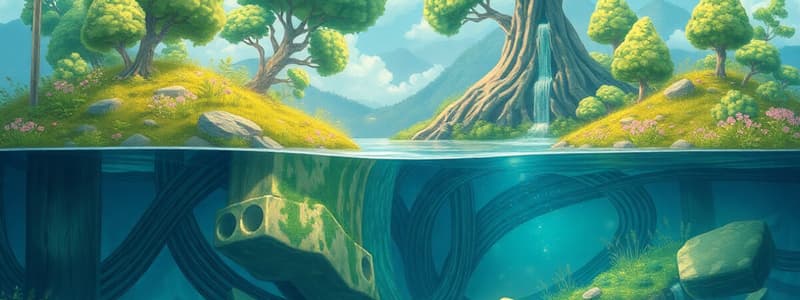Podcast
Questions and Answers
What does population density refer to?
What does population density refer to?
- The average age of individuals in a population
- The total area occupied by a group of individuals
- The number of different species in an area
- The number of individuals per unit area (correct)
Which of the following statements correctly describes a community in ecology?
Which of the following statements correctly describes a community in ecology?
- It consists solely of individuals from one species.
- It is a collection of different populations interacting in a shared environment. (correct)
- It refers to the physical environment where organisms live.
- It includes both abiotic and biotic components.
What is a key factor that can limit population growth?
What is a key factor that can limit population growth?
- Enhanced reproductive strategies
- Scarcity of resources (correct)
- Increased birth rates
- High levels of immigration
Which of the following is not an abiotic factor affecting ecosystems?
Which of the following is not an abiotic factor affecting ecosystems?
Flashcards are hidden until you start studying
Study Notes
Ecosystem Dynamics
- Ecosystems consist of living organisms (biotic components) and their physical environment (abiotic components).
- Ecoystem dynamics refers to changes and interactions within ecosystems, including population dynamics, species interactions, and environmental changes.
- Key interactions include:
- Predation
- Competition
- Symbiosis (mutualism, commensalism, parasitism)
- Disturbances (natural or human-induced) can lead to succession, a series of changes in species composition over time.
Biogeochemical Cycles
- Essential processes for nutrient recycling in ecosystems.
- Main cycles include:
- Water Cycle: Precipitation, evaporation, condensation, transpiration.
- Carbon Cycle: Photosynthesis (carbon fixation), respiration (CO2 release), decomposition, fossil fuel formation.
- Nitrogen Cycle: Nitrogen fixation, nitrification, denitrification, ammonification; involves bacteria and soil.
- Phosphorus Cycle: Weathering of rocks, uptake by plants, transfer through food webs, and sedimentation.
Energy Flow in Ecosystems
- Energy enters ecosystems primarily through sunlight, utilized by producers (e.g., plants) during photosynthesis.
- Energy transfer follows these pathways:
- Producers (autotrophs): Convert solar energy into chemical energy.
- Consumers (heterotrophs): Obtain energy by consuming other organisms (herbivores, carnivores, omnivores).
- Decomposers (detritivores): Break down dead organic material, returning nutrients to the soil.
- Energy transfer is inefficient; typically, only about 10% of energy is passed from one trophic level to the next.
Trophic Levels
- Hierarchical levels of energy transfer within ecosystems, categorized as follows:
- Primary Producers: Organisms that create energy from sunlight or inorganic substances (e.g., plants, algae).
- Primary Consumers: Herbivores that eat producers (e.g., rabbits, deer).
- Secondary Consumers: Carnivores that eat primary consumers (e.g., snakes, foxes).
- Tertiary Consumers: Apex predators that eat secondary consumers (e.g., hawks, lions).
- Decomposers: Break down dead organisms, recycling nutrients back into the ecosystem.
- Trophic pyramids illustrate the distribution of energy and biomass across trophic levels; energy, biomass, and numbers typically decrease at higher levels.
Ecosystem Dynamics
- Ecosystems involve both living and non-living components.
- Interactions within ecosystems include predation, competition, and symbiosis, leading to changes in population sizes and species compositions.
- Disturbances, such as natural disasters or human activities, can cause succession, a gradual change in the community of organisms over time.
Biogeochemical Cycles
- Nutrient recycling is critical for ecosystem functioning.
- The water cycle involves evaporation, condensation, precipitation, and transpiration.
- The carbon cycle includes photosynthesis, respiration, decomposition, and fossil fuel formation.
- The nitrogen cycle involves nitrogen fixation, nitrification, denitrification, and ammonification, primarily carried out by bacteria.
- The phosphorus cycle involves weathering of rocks, uptake by plants, transfer through food webs, and sedimentation.
Energy Flow in Ecosystems
- Energy enters ecosystems primarily through sunlight.
- Producers convert light energy into chemical energy through photosynthesis.
- Consumers feed on other organisms to obtain energy, categorized as herbivores, carnivores, and omnivores.
- Decomposers break down dead organic matter, releasing nutrients back into the ecosystem.
- Energy transfer is inefficient, with only about 10% of energy moving from one trophic level to the next.
Trophic Levels
- Trophic levels represent hierarchical feeding relationships within ecosystems.
- Primary producers form the base, converting sunlight into energy.
- Primary consumers feed on producers.
- Secondary consumers prey on primary consumers.
- Tertiary consumers are apex predators, consuming secondary consumers.
- Decomposers break down dead organisms, recycling nutrients.
- Trophic pyramids illustrate the decrease in energy, biomass, and individuals at higher trophic levels.
Ecological Interactions
- Interactions between organisms within an ecosystem influence population dynamics, community structure, and overall ecosystem stability.
- Predation: A predator-prey relationship where one organism (the predator) kills and eats another (the prey).
- This interaction significantly impacts population dynamics and community structure.
- Competition: Occurs when two or more species strive for the same limited resources, such as food, light, or shelter.
- It can occur between species (interspecific) or within the same species (intraspecific).
- Competition can drive the evolution of adaptations to reduce competition, like resource partitioning and niche differentiation.
- Mutualism: A symbiotic relationship where both participating species benefit.
- Example: Pollinators (like bees) benefit from nectar while flowering plants benefit from pollination.
- Commensalism: A relationship where one species benefits, and the other is neither harmed nor helped.
- Example: Barnacles attaching to a whale for transportation.
- Parasitism: A relationship where one species (the parasite) benefits at the expense of another (the host).
- Parasites often harm the host, but not immediately lethal.
- This interaction can have significant effects on host populations.
Ecological Succession
- Ecological succession describes the gradual process of change in species composition within an ecosystem over time.
- Primary Succession: Occurs on previously uninhabited terrains, such as land formed after a volcanic eruption.
- It represents a gradual process of soil formation and colonization by pioneer species.
- Secondary Succession: Occurs following disturbances that alter existing communities but do not completely destroy life, like forest fires.
- The process allows for faster repopulation by remaining or incoming species.
Trophic Levels
- Trophic levels represent the hierarchical feeding relationships within ecosystems.
- Producers (Autotrophs): Organisms that convert sunlight into energy through photosynthesis, like plants.
- Primary Consumers (Herbivores): Organisms that consume producers, like rabbits or deer.
- Secondary Consumers (Carnivores): Organisms that prey on primary consumers, like foxes or owls.
- Tertiary Consumers: Organisms that consume secondary consumers, like hawks.
- Decomposers: Organisms that break down dead organisms, returning nutrients to the ecosystem, like fungi and bacteria.
Ecosystem Balance
- The stability of an ecosystem depends on the intricate balance of interactions between species.
- Disrupting one species can have a significant impact on the entire community due to the interconnectedness of these interactions.
Human Impact
- Habitat fragmentation, pollution, and climate change all negatively impact ecological interactions.
- Species extinction disrupts food webs and ecological balances.
Conservation
- Protecting ecological interactions is vital for maintaining biodiversity and ecological integrity.
- Conservation efforts focus on restoring natural habitats and preserving the interactions they support.
Individual Organisms
- Most basic unit of ecology; a single member of a species.
- Interact with both living (biotic) and non-living (abiotic) factors.
- Adaptations and behaviors help them survive in their environment.
- Important for reproduction and maintaining a stable internal environment (homeostasis).
Populations
- Group of individuals of the same species in a specific area.
- Population density refers to the number of individuals per unit area.
- Distribution describes how individuals are spatially arranged.
- Populations can grow exponentially (rapidly) or logistically (limited by resources).
- Birth rates, death rates, immigration, and emigration all influence population size.
Communities
- Collection of different populations interacting in a shared environment.
- Symbiotic relationships:
- Mutualism (both species benefit)
- Commensalism (one species benefits, the other is unaffected)
- Parasitism (one species benefits, the other is harmed)
- Competition can occur within the same species (intraspecific) or between different species (interspecific).
- Predation plays a role in population control, with predator-prey dynamics.
- Biodiversity refers to the variety of species within a community, contributing to ecological stability.
Ecosystems
- Formed by the interaction of a community with its physical environment (abiotic factors).
- Includes living components (biotic) like plants, animals, and microorganisms.
- Non-living components (abiotic) include factors like climate, soil, water, and minerals.
- Energy flow:
- Producers (autotrophs) convert sunlight into energy through photosynthesis.
- Consumers (heterotrophs) obtain energy by eating other organisms.
- Decomposers break down dead organisms, recycling nutrients back into the ecosystem.
- Trophic levels are hierarchical levels in an ecosystem:
- Producers form the base.
- Primary consumers feed on producers.
- Secondary consumers feed on primary consumers.
- Top predators occupy the highest level.
- Maintaining ecosystem stability is influenced by species diversity and the presence of keystone species (having a disproportionate impact on the ecosystem).
Population Dynamics
- Study of how populations change over time and space.
- Population size: Number of individuals in a population.
- Population density: Number of individuals per unit area or volume.
- Reproductive strategies:
- K-strategists: Few offspring, high parental care, an example is elephants
- R-strategists: Many offspring, low parental care, an example is insects
- Growth models:
- Exponential Growth: Ideal conditions, unrestricted growth, represented by a J-shaped curve
- Logistic Growth: Limited resources, stabilizes at carrying capacity, represented by an S-shaped curve
- Factors Affecting Dynamics: Birth rates, death rates, immigration, emigration.
Abiotic and Biotic Factors
- Abiotic Factors: Non-living chemical and physical parts of the environment, examples include sunlight, temperature, water, soil, nutrients, and climate.
- Biotic Factors: Living components of an ecosystem that influence populations, examples include predation, competition, disease, and symbiosis (mutualism, commensalism, parasitism).
Community Structure
- The organization and composition of a community, including species richness (variety of species) and evenness (abundance distribution).
- Trophic Levels:
- Producers (autotrophs): Convert sunlight/chemicals into energy.
- Consumers (heterotrophs): Herbivores (primary), carnivores (secondary), omnivores, decomposers.
- Species Interactions:
- Competition: Struggle for limited resources.
- Predation: One species preys on another.
- Symbiosis: Interactions between different species.
- Ecological Niche: Role and position of a species within its environment, which includes habitat, resource use, and interactions.
- Dynamics: Community structure can change due to disturbances (natural disasters, human activities) leading to succession (primary or secondary).
Studying That Suits You
Use AI to generate personalized quizzes and flashcards to suit your learning preferences.




